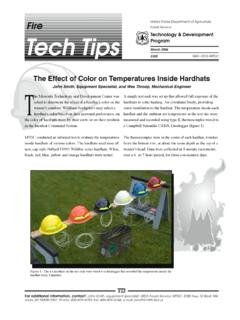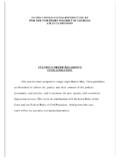Transcription of FHTET-2003-01 January 2003 - US Forest Service
1 FHTET-2003-01 January 2003 Front Cover:Clockwise from top left: white oak (Q. alba) acorns; willow oak (Q. phellos) leaves and acorns; Georgia oak (Q. georgiana) leaf; chinkapin oak (Q. muehlenbergii) acorns; scarlet oak (Q. coccinea) leaf; Texas live oak (Q. fusiformis) acorns; runner oak (Q. pumila) leaves and acorns; background bur oak (Q. macrocarpa) bark. (Design, D. Binion)Back Cover:Swamp chestnut oak (Q. michauxii) leaves and acorns. (Design, D. Binion) field guide to Native Oak Species of Eastern North AmericaJohn Stein and Denise BinionForest Health Technology Enterprise TeamUSDA Forest Service180 Canfield St., Morgantown, WV 26505 Robert AcciavattiForest Health ProtectionNortheastern Area State and Private ForestryUSDA Forest Service180 Canfield St.
2 , Morgantown, WV 26505 Forest HEALTHTECHNOLOGY ENTERPRISE TEAMTECHNOLOGYTRANSFEROak IdentificationUnited States Department ofAgricultureFHTET-2003-01 January 2003 ForestServiceiiiiiNORTH AMERICA 100th MeridianiiiiiACKNOWLEDGMENTSThe authors wish to thank all those who helped with this publication. We are grateful for permission to use the drawings illustrated by John K. Myers, Flagstaff, AZ, published in the Flora of North America, North of Mexico, vol. 3 (Jensen 1997). We thank Drs. Cynthia Huebner and Jim Colbert, Forest Service , Northeastern Research Station, Disturbance Ecology and Management of Oak-Dominated Forests, Morgantown, WV; Dr. Martin MacKenzie, Forest Service , Northeastern Area State and Private Forestry, Forest Health Protection, Morgantown, WV; Dr.
3 Steven L. Stephenson, Department of Biology, Fairmont State College, Fairmont, WV; Dr. Donna Ford-Werntz, Eberly College of Arts and Sciences, West Virginia University, Morgantown, WV; Dr. Ron Lance, President, International Oak Society, Chimney Rock, NC; and Dr. Fernando Zavala-Chavez, Division of Forest Science, Universidad Autonoma Chapingo, Chapingo, Mexico, for their technical review comments. Their input helped to greatly improve the manuscript. In addition, we thank Claudia Violette, Frost Entomological Museum, Pennsylvania State University, University Park, PA, for her editorial services. We are indebted to the following sources for use of various oak images: Shirley Denton, Biological Research Associates, Tampa, FL; Joyce Foster, Forest Service , Sumter National Forest , Long Cane Ranger District, Edgefield, SC; Tihomir Kostadinov, Student, University of Richmond, Richmond, VA; Ron Lance, President, International Oak Society, Chimney Rock Park, Chimney Rock, NC; Chuck Milner, Forest Service , Cibola National Forest , Black Kettle Ranger District, Cheyenne, OK; Gil Nelson, Robert K.
4 Godfrey Herbarium, Florida State University, Tallahassee, FL; Guy Sternberg, Starhill Forest Arboretum, Petersburg, IL; Paul Wray, Department of Forestry, Iowa State University, Ames, IA (photos obtained from Forestry Images web site, University of Georgia); Texas A&M University, College Station, TX; and West Virginia University, Eberly College of Arts and Sciences (Herbarium), Morgantown, WV. Finally, the authors wish to extend their appreciation to Nancy Lough and Sandy Fosbroke, Forest Service , Northeastern Area State and Private Forestry, Information Management and Analysis, Morgantown, WV, for their advice and formatting of this field credits: R. Acciavatti Q. havardii (habitat), Q. ilicifolia (habitat); D.
5 Binion Q. bicolor (acorn, bark), Q. falcata (bark), Q. havardii (leaf), Q. nigra (bark), Q. phellos (bark); S. Denton Q. chapmanii (leaf, acorn), Q. falcata (acorn), Q. geminata (leaf, immature/mature acorn); J. Foster ivvQ. oglethorpensis (leaf, bark, tree); T. Kostadinov Q. coccinea (leaf), Q. falcata (leaf), Q. montana (bark), Q. nigra (leaf), Q. velutina (bark); R. Lance Q. acerifolia (leaf), Q. arkansana (leaf, acorn, bark), Q. austrina (leaf, acorn, bark), Q. boyntonii (leaf, acorn, tree), Q. buckleyi (leaf, acorn, bark), Q. coccinea (acorn), Q. fusiformis (leaf, acorn, bark), Q. georgiana (leaf, acorn), Q. hemisphaerica (leaf, acorn), Q. ilicifolia (acorn), Q. incana (leaf, acorn, bark), Q.
6 Laceyi (leaf, acorn), Q. laevis (leaf, acorn, bark), Q. laurifolia (leaf, acorn, bark), Q. lyrata (leaf, acorn), Q. margaretta (leaf, acorn, tree), Q. marilandica (leaf, acorn, bark), Q. michauxii (leaf, acorn, bark), Q. minima (leaf, acorn, habitat), Q. montana (leaf, acorn), Q. myrtifolia (leaf, acorn), Q. pagoda (leaf, acorn, bark), Q. phellos (leaf, acorn), Q. prinoides (leaf, acorn), Q. pumila (leaf, acorn, habitat), Q. shumardii (leaf, acorn), Q. similis (leaf, acorn, bark), Q. sinuata (leaf, acorn), Q. texana (leaf, acorn), Q. vaseyana (leaf, acorn), Q. virginiana (leaf, acorn); C. Milner Q. havardii (acorn); G. Nelson Q. inopina (acorn, leaf); J. Stein Q. ilicifolia (leaf, bark), Q. imbricaria (bark), Q.
7 Muehlenbergii (bark), Q. myrtifolia (bark), Q. nigra (acorn), Q. rubra (bark), Q. stellata (bark), Q. virginiana (bark, trunk, tree); G. Sternberg Q. macrocarpa (trunk), Q. mohriana (leaf, acorn, bark, tree), Q. pungens (leaf, acorn, habitat); Texas A&M Q. fusiformis (tree), Q. hemisphaerica (tree), Q. vaseyana (tree); West Virginia U. Q. coccinea (bark), Q. shumardii (bark); and P. Wray Q. alba (leaf, acorn, bark), Q. bicolor (leaf), Q. ellipsoidalis (leaf, acorn), Q. imbricaria (leaf, acorn), Q. macrocarpa (leaf, acorn, bark), Q. muehlenbergii (leaf, acorn), Q. palustris (leaf, acorn, bark), Q. rubra (leaf, acorn), Q. stellata (leaf, acorn), Q. velutina (upper/lower leaf surface, acorn). Permission should be obtained from the photographers to receive and use quality images for Forest Service , Forest Health Technology Enterprise Team, Morgantown, WV, published this book with support from the Forest Service s Northeastern Area State and Private Forestry, Forest Health Protection, Newtown Square, PA; Northeastern Area State and Private Forestry, Information Management and Analysis, Morgantown, WV; and the Southern Region, Forest Health Protection, and Cooperative Forestry, Atlanta, OF CONTENTSI ntroduction.
8 1 Species Descriptions ..5Q. white white pin red live live laurel post chestnut live chinkapin red post red live of Eastern North America ..106 Ecoregion Province Summary ..108 Table 1. Native Red 2. Native White to Leaves of Eastern Native Oaks ..120 Leaf ..148 Selected References ..151 Index of Common Names ..153 Index of Scientific Names ..157 Reference Charts for Red and White Oak Leaves ..161- 1 -Oaks are primarily temperate region trees and shrubs numbering approximately 600 species worldwide.
9 Oaks have occupied the non-glaciated landscape of North America since the Cretaceous Period. Fifty oak species are represented in two-thirds of the eastern North American Forest cover types and dominate 68 percent of hardwood forests (191 million acres).Oaks have figured prominently in folklore, construction, food sources, medications, and dyes. Great political events have occurred under charter oaks, and Native Americans utilized acorns as food (particularly the sweeter white oaks) and the inner bark as medicine (Q. falcata, Q. ilicifolia, Q. imbricaria, Q. muehlenbergii, Q. rubra, and others). This genus, which includes economically important hardwoods, is also critical for meeting watershed, recreation, and wildlife management encroachment of urbanization, agriculture, and hydrologic projects continues to negatively impact oak Forest types.
10 Such impacts may necessitate the establishment of conservation districts for vulnerable species. Comments in the text associated with conservation status are based upon information compiled by the World Conservation Monitoring Center and published in association with the International Union for Conservation of Nature and Natural Resources (IUCN) in the 1997 IUCN Red List of Threatened Plants (Walter and Gillett 1998). In the southern United States, Forest management practices favor conifers replacing hardwood forests in rich bottomlands. A new source of concern involves the threat of displacement of native oaks by exotic species. Forest types are placed at risk with the introduction of non-native insects, diseases, and plants.













